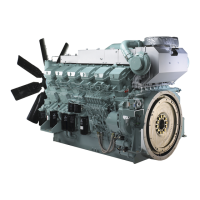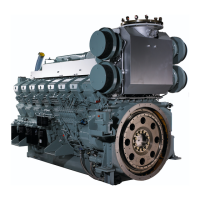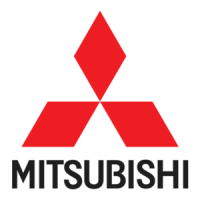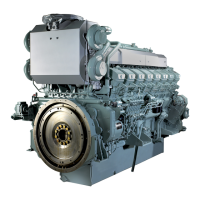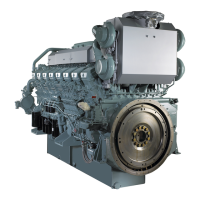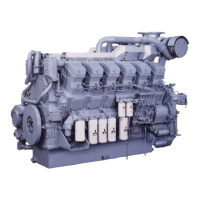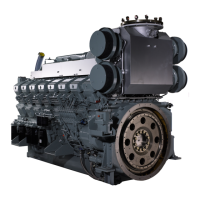

Do you have a question about the Mitsubishi S16R Series and is the answer not in the manual?
| Fuel Type | Diesel |
|---|---|
| Cooling System | Water-cooled |
| Starting System | Electric starter |
| Engine Type | 4-cycle, water-cooled, direct injection |
| Aspiration | Turbocharged, Intercooled |
| Rotation | Counter-clockwise (viewed from flywheel side) |
| Fuel System | Direct injection |
| Lubrication System | Forced lubrication |
| Engine Model | S16R |
Defines the engine's general purpose and suitable applications in industrial power generation.
Outlines general safety guidelines for operation, inspection, and maintenance by qualified personnel.
Provides crucial advice for ensuring safety during engine operation, inspection, and maintenance.
Lists points for user companies to ensure safety management and handling of engine modifications.
Explains the manual's structure, content, and how to use it effectively.
Explains where to find the engine's nameplate and the information it contains.
Presents key technical specifications for the S16R and S16R2 engine models in a table.
Outlines categories for detailed engine specifications to be filled in by the user.
Provides safety instructions for preventing personal injury and highlights critical risks.
Explains the meanings of symbols used for warnings and the importance of legible labels.
Lists guidelines for preventing injuries, accidents, and environmental pollution.
Details necessary preparations like fire-fighting equipment and emergency action plans.
Stresses the importance of wearing appropriate PPE for various tasks to prevent injury.
Provides critical safety guidelines for handling and charging the engine's battery.
Describes operation methods and daily checks for engine startup and environment.
Lists essential checks for fuel, coolant, oil, battery, and air systems before starting.
Outlines procedures for starting the engine using various starting systems.
Explains the importance and procedure for warming up the engine and general operation.
Details checks to perform while the engine is running, noting abnormalities.
Describes engine cooling before stopping and correct stopping procedures.
Provides safety precautions for handling fuel, including static electricity and storage.
Lists fuel properties and their required standards for engine operation.
Details engine oil properties, quality standards, and recommendations for use.
Explains the relationship between temperature and viscosity, and safe handling.
Specifies water quality standards and requirements for Long Life Coolant (LLC).
Provides safety precautions for handling coolant and outlines LLC maintenance procedures.
Explains the procedure for measuring LLC concentration using a coolant tester.
Guides users on how to utilize the scheduled maintenance program for safe operation.
Classifies maintenance tasks and intervals for continuous vs. emergency engine use.
Lists scheduled maintenance tasks and intervals for engines used continuously.
Lists scheduled maintenance tasks and intervals for emergency use engines.
Lists critical safety precautions to be followed before and during inspection/maintenance.
Covers visual checks of engine body components like belts and dampers.
Details inspection and maintenance of fuel filters, tanks, and bleeding procedures.
Outlines procedures for engine oil changes, refills, and level checks.
Covers inspection of cooling system components and coolant replacement.
Details checking and cleaning of air cleaner and pre-cleaner elements.
Covers inspection of battery, starter motor, and alternator.
Details checks for air starting systems like air tanks and motors.
Outlines procedures for storing the engine in an inoperable state for extended periods.
Details rust-preventive measures and general preparation steps for storage.
Provides a step-by-step procedure for safely restarting the engine after storage.
Outlines safety precautions and legal requirements for transporting the engine and lifting procedures.
Shows the center of gravity dimensions for S16R and S16R2 engine models.
Lists critical safety precautions and a systematic approach to troubleshooting.
Details causes and remedies for engine starting failures.
Explains causes and solutions for engine output shortage and exhaust smoke.
Identifies causes and remedies for excessive fuel/oil consumption and overheating.
Provides procedures for engine stops and responses to thermo switch activation.
Details parts supply periods, availability, and procedures for requesting repairs.
Advises on contacting SME dealer for service and providing necessary engine details.
Lists precautions for safe and legal disposal of engine fluids like fuel, oil, and coolant.
Provides guidance on disposal of engine bodies and other waste materials, ensuring compliance.
Lists detailed engine oil quality standards and service limits.
Specifies coolant requirements, quality standards, and LLC details.
Explains why LLC is needed and potential problems from its misuse.
